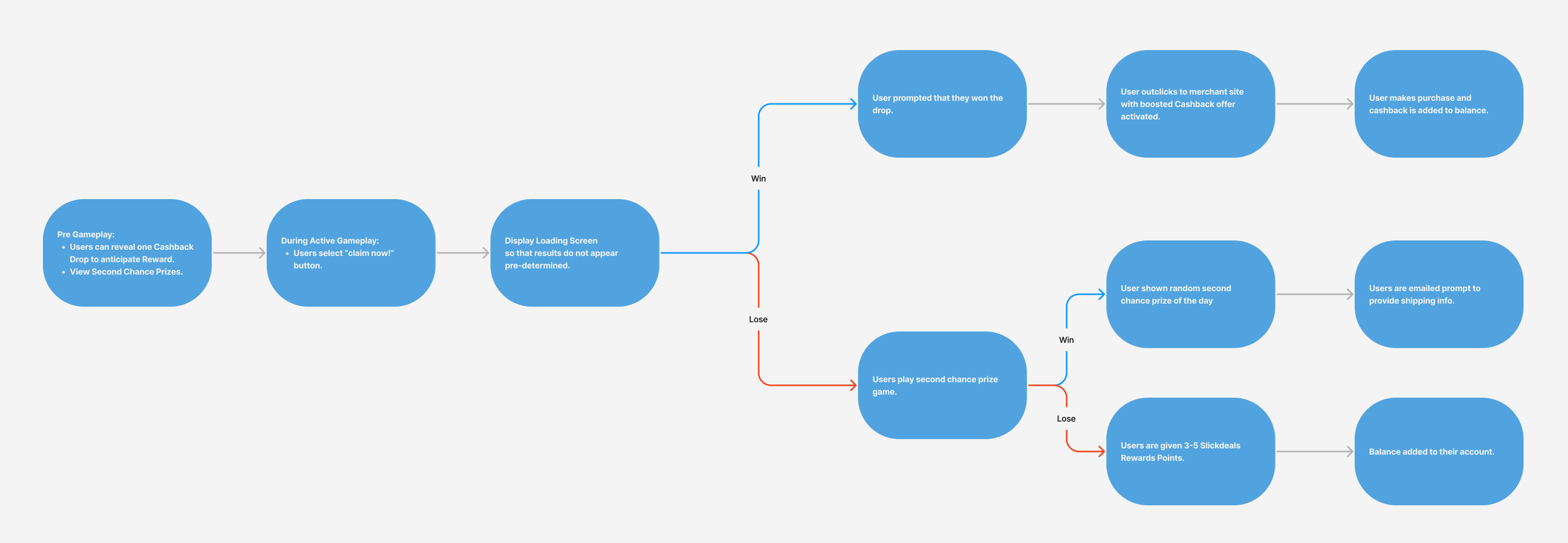Context
Slickdeals Rewards is an online Cashback program that allows Slickdeals Extension users to earn points through their online purchases. Users can redeem these Rewards Points towards online gift cards and PayPal transfer. Slickdeals Rewards has been in Beta since 2020 when the program launched as a value-stream feature of the Slickdeals Extension.
Since the program had been in Beta for around a year and sufficiently accomplished its business objectives in the company, the Rewards team was tasked with creating a lucrative promo to acquire as many users as possible towards the program and Extension as a form of public launch.
Timeline
Two Weeks for Final Design
Project Role
Product Design Lead
Scope
Buildable by Devs in Two Weeks
Project Timeline
What motivates our Audience?
Slickdeals has been around since 1999 and according to existing research by the company, the unifying factor across our userbase is that they tend to be shoppers who view deal hunting as a sport or game. Since Slickdeals also functions as a deal forum, roughly about 20% of them actively contribute to the comments section of each deal discussing their purchase — almost like a post-match thread after a game. The remaining users are called lurkers, who read the threads to make their purchasing decisions.
In conversations with the team, we determined that we could make use of this social aspect to have a compounding, viral effect of this promo by utilizing community engagement.
What are we motivating them to do?
In our context of acquiring users to Slickdeals Rewards, we needed an intuitive way to get users to follow our three technical requirements for joining the program.
Project Goals
With these considerations in mind, my key metrics and design requirements were beginning to take form.
Acquisition: Have an intuitive UX that makes it easy for users to be eligible for the promotion
Retention: Present our incentives in an engaging way that makes them come back
Engagement: Create a way for users to discuss the promotion amongst each other.

Diving Dipping into the Research
Since we only had two weeks to research, design and prototype this promotion, I knew that I needed to be as scrappy as possible with the research. Thus, based on my requirements I set to learn more about 2 things:
Determine what has previous generated lots of hype around a deal or promotion in the past to replicate.
Figure out the performance of our various existing acquisition flows to repurpose.
We agreed as a product team that this promotion would be run multiple times, we would use this version as a V1 to gain feedback from users to improve and iterate in the following promos.
Following the Hype
After combing through some old deal threads, we determined that Price Mistakes were the highest engagement type of deals in the past — that is, deals where merchants mistakenly entered a wrong (and heavily discounted price) price for a deal. Historically, this included things like a $100 Digital Camera that was typically $1500, or a category page of $5 sales which included things like a $500 Gift card. After conversations with Product, we sought to replicate this type of experience for Offer Drops.
Don’t Fix what ain’t Broke
I worked with the data team to determine the best performing acquisition flow from a clickthrough perspective and spoke with long-time slickdeals veterans to dig up old deal threads on killer deals. This was our paciest option since this existing flow had ready built logic to both log users into Slickdeals and Opt them into Rewards. A double bareled solution.
So what exactly did we build?
Enter Offer Drops, a time-based game where users could click a button at a pre-determined time to instantly win prizes such as PS5’s, rare Graphics Cards, and up to 100% Cashback at select stores.
The first few users across the country to play would click on a CTA to get wildly high Cashback rates. After all of the High Cashback rates were claimed, users would get the chance to win a second chance prize. One lucky winner would win a highly sought-after product, such as a PS5 or rare Graphics card, and the rest would get a few rewards points for participating.
Design Approach
This means that there needed to be a clear progression of gameplay where users could understand which prizes they’re about to play for. As such, I diagramed these steps to ensure that the gameplay would follow a progression that made sense from a user satisfaction perspective.







